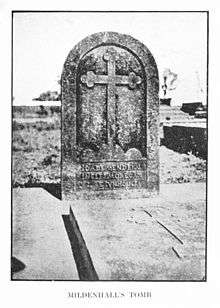John Mildenhall
John Mildenhall (1560–1614) or John Midnall was a British explorer and adventurer and one of the first to make an overland journey to India. He was the self-styled ambassador of the British East India Company in India. His is the first recorded burial of an Englishman in India.[1]
Early life
John Mildenhall was born in 1560 in Little Bedwin, Wiltshire, England.[2] He was the son of Sir John Mildenhall.
Marriage
John Mildenhall married Elizabeth Bates in England in 1579.
Travels to India
Mildenhall was one of the first British travellers to journey overland to India.[3] His name first appears in the Court Records of the British East India Company concerning a letter sent by him "to his master Rich Stapers, declaring what privileges he had obtained in the Indies and offering them, and his services to the Company for 1,500 pounds in hand". On 21 June 1608 the Court decided to consider his demand, and in October nominated Mildenhall as factor along with Lawrence Femell and Edward Abbott. However, Mildenhall demanded even more and as a consequence, negotiations came to an end.
Entrusted with the sale of the Company goods in the Levant, Mildenhall, travelled through Eastern Europe, passed through Scio and Smyrna, and reached Constantinople on 29 October 1599. After a six month stay in Constantinople, he continued his journey and arrived at Aleppo on 24 May 1600 where he stayed for forty-two days. On 7 June 1600 Mildenhall left Aleppo with an entourage of six hundred people and, after travelling through Bir, Urfa, Diabekir, Butelis, Van, Nakhichevan, Julfa, Sultanieh, Kazvin, Kum, Kashan, Kirman, Sistan and Kandahar, he reached Lahore in 1603.
Mildenhall was entrusted with the sale of the Company's goods in the Levant but he deceived the British East India Company by escaping to Persia instead. A letter from Ajmer dated 20 September 1614 informs the British East India Company that an Englishman named Richard Steele had arrived at Aleppo along with another Englishman, Richard Newman, in pursuit of one John Midnall who had tried to flee with the Company's provisions to India but was overtaken and captured at Tombaz and taken back to Isfahan.
Mildenhall was released soon afterwards but his goods were confiscated. However, he received compensation of 9,000 dollars in return. Soon after his release, Mildenhall travelled to India and reached Lahore in the company of Newman who had had an altercation with Steele and had chosen to follow Mildenhall. They parted at Lahore but reunited at Agra.
Mildenhall reached the court of the Mughal Emperor Akbar and held discussions with him. However, he was regarded as an outlaw by the British East India Company whose exports to the Levant he had diverted to India. Moreover, his journey was not sponsored by the Company. Hence, the British East India Company sent Sir William Hawkins to India in pursuit of Mildenhall and to declare all his dealings null and void.
Burial

John Mildenhall is interred at the Roman Catholic cemetery in Agra, India under the following inscription:
- Here lies John Mildenhall, Englishman, who left London in 1599 and traveling to India through Persian, reached Agra in 1600 and spoke with the Emperor Akbar. On a second visit in 1614 he fell ill at Lahore, died at Ajmer, and was buried here through the good offices of Thomas Kerridge merchant.[4]
References
- ↑ "The Minalls of Wiltshire, Berkshire, & Hertfordshire, England". Retrieved 2008-05-29.
- ↑ "Mendenhall Family History — Thirteenth Generation". Retrieved 2008-05-27.
- ↑ Prasad, Ram Chandra (1980). Early English Travellers in India. Motilal Banarsidass Publications. p. 63. ISBN 8120824652.
- ↑ "Agra — Beyond Taj". Retrieved 2009-06-29.
5. Early Travels in India 1583-1619, Sir William Foster, 1921